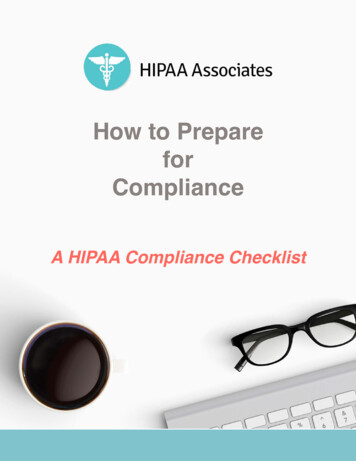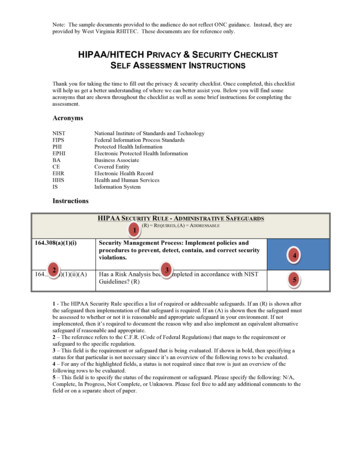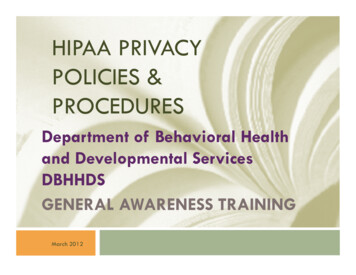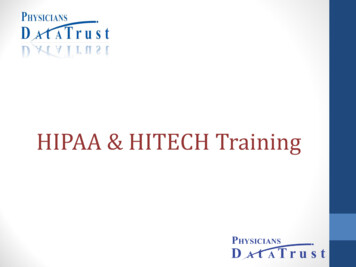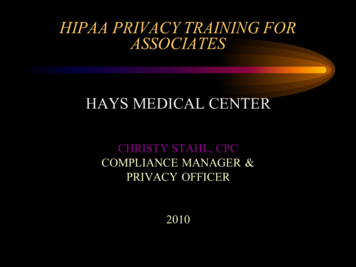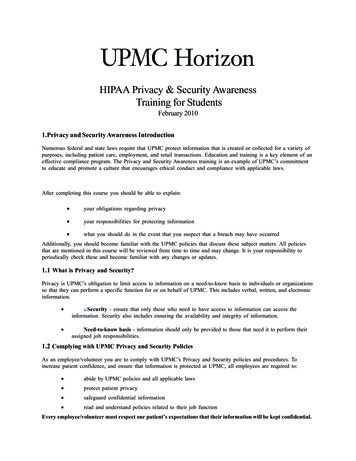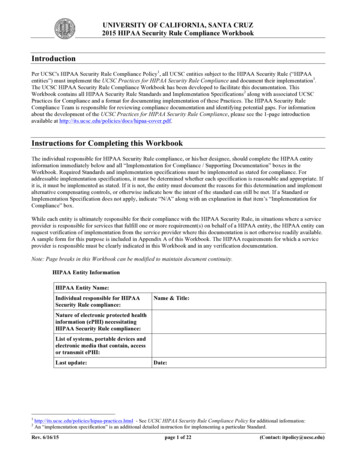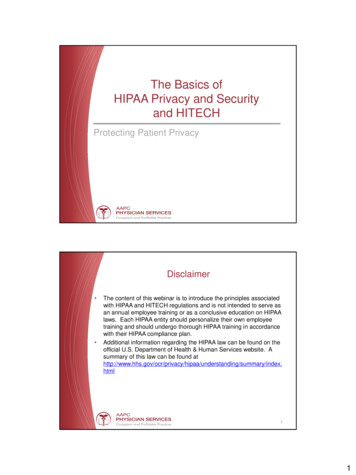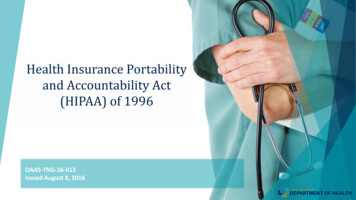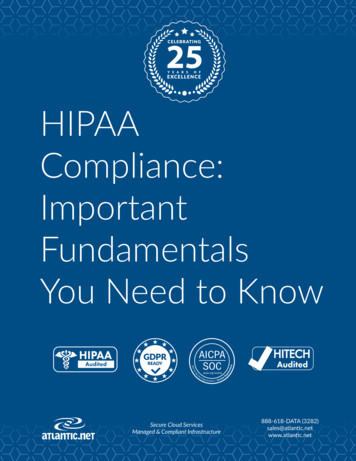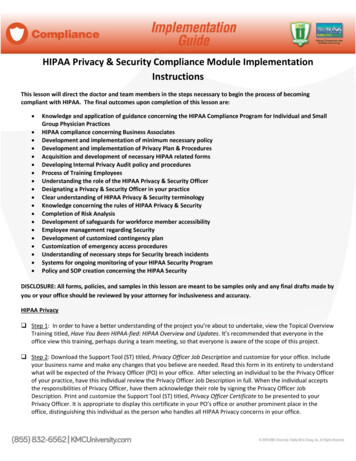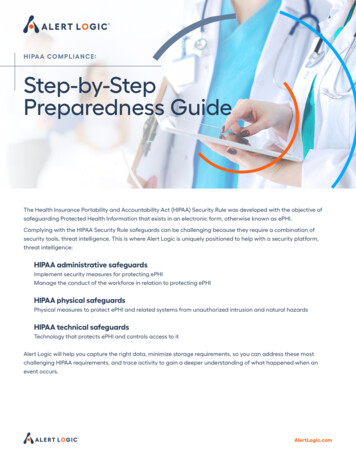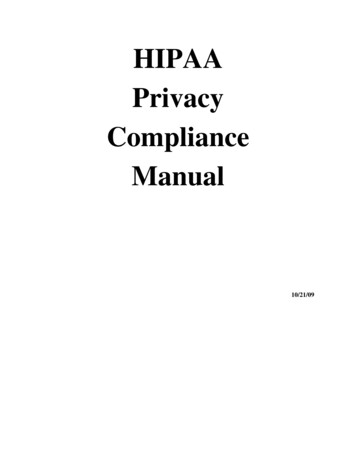
Transcription
HIPAAPrivacyComplianceManual10/21/09
HOW TO USE THIS MANUALThis HIPAA Compliance Manual is an interactive workbook to help you comply with the HIPAAPrivacy Rule. (45 CFR 164.500 et. seq.)We intend for you to download the electronic version of this Workbook so that you have a papercopy to work with. You may wish to put the Workbook in a three ring binder for ease of use. In thisformat, more than one person in your office can be working on the various sections of the Workbooksimultaneously. It will also allow you to insert additional pages if you need to in your compliance effort,or to store other HIPAA materials that you may have in a single place.When you use this Workbook, you will be asked questions about your current privacy practices.Based upon your answers, you will be able to decide if a particular HIPAA privacy requirement applies toyou or not. If it does, the Workbook will help you determine what specific action steps you need to take inorder to comply. You will have model policies, procedures, and forms to work with to get you started.When you finish using this Workbook, you should have developed a series of new or revisedpolicies and procedures for privacy protections in your office. It will then be up to you to train your workforce in how to use these, and to enforce them. When you have appropriate written policies andprocedures, appropriate forms and contracts, and a work force that is trained and ready to implementthem, you can then consider yourself to be compliant with HIPAA's Privacy Rule.HIPAA compliance will take effort and possibly some funds. The Workbook will help youorganize yourself and establish a budget that you can live with. You don't need to spend thousands ofdollars to become HIPAA compliant if you use your existing resources and personnel wisely.As you know, HIPAA is a federal law. Your own state may already have laws relating to theprivacy of health information. This Workbook explains how these state laws will relate to HIPAA. Youmay have to comply with both an existing state law and the new HIPAA requirements. Sometimes thestate law will “trump” HIPAA, and you will only have to comply with the existing state law. Because thelaws in states vary, this Workbook cannot give you detailed information on how to satisfy your state laws.You are advised to consult your own attorney or state association for assistance.Similarly, this Workbook cannot presume to know how each doctor's professional practice is setup. The Workbook provides you with general information; you will need to tailor it to your own practice.This Workbook does not address HIPAA's electronic data interchange (EDI) rules, or theproposed security rules.Finally, this Workbook is not legal advice. It is provided as an informational tool to assistyou in becoming compliant with HIPAA. Nothing in this Workbook is intended to create anyattorney-client relationship between you and either NYSDA or NYSDA’s legal counsel. For legaladvice, you are advised to consult your own private attorney.
TABLE OF CONTENTSTITLECHART #IS YOUR PRACTICE SUBJECT TO HIPAA?.1WILL YOU HAVE TO BILL MEDICARE ELECTRONICALLY? .2DOES THE WAY THAT YOUR BUSINESS IS ORGANIZEDAFFECT HOW YOU COMPLY WITH HIPAA? .3AFFILIATED COVERED ENTITIES (POLICY 3A)HEALTH CARE COMPONENTS (POLICY 3B) .3DO YOU HAVE AN OVERALL WORK PLAN AND BUDGETFOR HIPAA COMPLIANCE IMPLEMENTATION? .4MODEL TIME LINE .4YOU MUST APPOINT A PRIVACY OFFICER AND A PUBLIC INFORMATION OFFICER .5PRIVACY OFFICER JOB DESCRIPTION (POLICY 5A)PUBLIC INFORMATION OFFICER JOB DESCRIPTION (POLICY 5B) .5WHERE AND HOW ARE YOU USING OR DISCLOSINGPROTECTED HEALTH INFORMATION? .6WHEN DO YOU NEED TO HAVE THE PATIENT SIGN AN AUTHORIZATION? .7NO AUTHORIZATION IS REQUIRED TO MAKE CERTAINDISCLOSURES OF PROTECTED HEALTH INFORMATION (POLICY 7A) .7YOU DO NOT NEED A SIGNED PATIENT AUTHORIZATION TO USE OR DISCLOSEPHI FOR TREATMENT, PAYMENT, OR HEALTH CARE OPERATIONS .8NO AUTHORIZATION IS REQUIRED TO MAKE CERTAINDISCLOSURES OF PROTECTED HEALTH INFORMATION (POLICY 8A) .8YOU DO NOT NEED A SIGNED PATIENT AUTHORIZATION FORFACILITY DIRECTORIES, OR TO SHARE PHI WITH CAREGIVERS .9FACILITY DIRECTORY (POLICY 9A) .9PROVIDING INFORMATION TO FAMILY AND FRIENDSOF PATIENTS INVOLVED IN CARE (POLICY 9B) .9YOU DO NOT NEED AN AUTHORIZATION FOR DISCLOSURESFOR “PUBLIC POLICY” PURPOSES .10NO AUTHORIZATION IS REQUIRED TO MAKE CERTAINDISCLOSURES OF PROTECTED HEALTH INFORMATION (POLICY 10A) .10YOU MAY NEED AN AUTHORIZATION TO USE OR DISCLOSEPHI FOR MARKETING OR ADVERTISING – IT DEPENDS ONTHE AVAILABILITY OF AN EXCEPTION.11MARKETING AND ADVERTISING (POLICY 11A) .11
TABLE OF CONTENTSTITLECHART #YOU MAY NEED AN AUTHORIZATION TO USE OR DISCLOSE PHI FORRESEARCH – IT DEPENDS ON THE AVAILABLE EXCEPTIONS .12DISCLOSURES FOR RESEARCH (POLICY 12A) .12YOU MUST PREPARE A SPECIAL FORM FOR PATIENTS TOAUTHORIZE THE USE OR DISCLOSURE OF THEIR PHI .13AUTHORIZATION FOR RELEASE OF IDENTIFYINGHEALTH INFORMATION (POLICY 13A) .13PERSONAL REPRESENTATIVES FOR PATIENTS (POLICY 13B) .13YOU MUST NOTIFY PATIENTS ABOUT PRIVACY .14NOTICE OF PRIVACY PRACTICES (POLICY 14A) .14YOU NEED TO ALLOW PATIENTS TO INSPECT AND COPY THEIR PHI .15DESIGNATED RECORD SET (POLICY 15A) .15PATIENTS’ ACCESS TO THEIR PROTECTEDHEALTH INFORMATION (POLICY 15B) .15MODEL LETTERS REGARDING INSPECTION AND COPYING .15YOU NEED TO AMEND PHI UPON REQUEST IF IT ISINACCURATE OR INCOMPLETE .16DESIGNATED RECORD SET (POLICY 16A) .16AMENDMENT OF PROTECTED HEALTH INFORMATION (POLICY 16B) .16MODEL LETTERS REGARDING REQUEST TO AMEND INFORMATION .16YOU NEED TO GIVE PATIENTS AN ACCOUNTING OFDISCLOSURES OF THEIR PHI .17ACCOUNTING FOR DISCLOSURES OFPROTECTED HEALTH INFORMATION (POLICY 17A).17MODEL LETTER REGARDING REQUEST FOR ACCOUNTING .17YOU MUST ALLOW PATIENTS TO ASK YOU TO RESTRICT HOW YOU USEPHI FOR TREATMENT, PAYMENT, OR HEALTH CARE OPERATIONS.18RESTRICTIONS ON THE USE OF PROTECTEDHEALTH INFORMATION (POLICY 18A) .18YOU MUST ALLOW PATIENTS TO SPECIFY CONFIDENTIALMETHODS OF RECEIVING COMMUNICATIONS FROM YOU .19CONFIDENTIAL COMMUNICATION METHODSWITH PATIENTS (POLICY 19A) .19WHAT IS A BUSINESS ASSOCIATE? .20
TABLE OF CONTENTSTITLECHART #YOU MUST HAVE A CONTRACT WITH YOUR BUSINESS ASSOCIATES .21DHHS SAMPLE BUSINESS ASSOCIATE CONTRACT PROVISIONS .21BUSINESS ASSOCIATE CONTRACT (POLICY 21A).21DO YOU HAVE CONTINUING OBLIGATIONS TOWARDSYOUR BUSINESS ASSOCIATES? .22YOU MUST SAFEGUARD PHI .23YOU MUST INTERNALLY USE OR EXTERNALLY DISCLOSEONLY THE MINIMUM NECESSARY AMOUNT OF PHI .24MINIMUM NECESSARY USES AND DISCLOSURES OF PHI (POLICY 24A) .24YOU MUST VERIFY THE CREDENTIALS OF THOSE WHO SEEK PHI .25VERIFICATION BEFORE DISCLOSING PROTECTEDHEALTH INFORMATION (POLICY 25A) .25YOU MUST MITIGATE THE HARM DONE BY A WRONGFULUSE OR DISCLOSURE OF PHI .26MITIGATION OF KNOWN HARM FROM AN IMPROPERDISCLOSURE OF PROTECTED HEALTH INFORMATION (POLICY 26A) .26YOU MUST HAVE A COMPLAINT POLICY AND PROCEDURE .27HANDLING PATIENT COMPLAINTS ABOUTPRIVACY VIOLATIONS (POLICY 27A) .27YOU CAN USE OR DISCLOSE DE-IDENTIFIED INFORMATION WITHOUTANY CONCERN ABOUT HIPAA’S PRIVACY PROTECTIONS .28DE-IDENTIFICATION OF PROTECTED HEALTH INFORMATION (POLICY 28A) .28THE RULES FOR PROTECTION OF PHI ARE RELAXED FOR LIMITED DATA SETS .29LIMITED DATA SETS (POLICY 29A)DATA USE AGREEMENT (POLICY 29B) .29YOU MUST TRAIN YOUR WORKFORCE .30SOME STATE PRIVACY LAWS REMAIN RELEVANT AFTER HIPAA .31
Completed DateIS YOUR PRACTICE SUBJECT TO HIPAA?Signature of responsible personAssessment QuestionYesNo1. Do you furnish, bill or receive payment for health care inthe normal course of business?Go on toquestion 2.You are not affectedby HIPAA unlessyou are a “healthplan” or a “healthcare clearinghouse.”Dentists always furnish health care.2. Do you conduct (either directly or through a contractedorganization like a billing company) any of the followinghealth care financial or administrative transactions:Go on toquestion 3.You are not affectedby HIPAA.1. Read the definitions on the accompanying pagecarefully before answering the questions. HIPAA usesvery specific meanings for its financial oradministrative transactions. health care claims or equivalent encounter information.health care payment and remittance advice.coordination of benefits.health care claim status.enrollment and disenrollment in a health plan.eligibility for a health plan.health plan premium payments.referral certification and authorization.first report of injury.health claims attachments.3. Do you conduct any of these transactions using electronicmedia?Comments2. You cannot avoid HIPAA by contracting with thirdparties to conduct any of these transactions on yourbehalf. See charts 20-21 for more information aboutusing contracted service providers.You areaffected byHIPAA.You are not affectedby HIPAA.1. Read the definitions on the accompanying pagecarefully before answering this question. HIPAA usesa very specific meaning for what is electronic media.2. The following is not considered electronic media: Using a word processor to prepare bills printed onpaper. Using a standard fax machine (distinguish fromcomputer generated faxes).1CHART 1
Question 1 Definitions: “Health care” means care, services, or supplies related to the health of an individual. It includes, but is not limited to, the following:(1) preventive, diagnostic, rehabilitative, maintenance, or palliative care, and counseling, service, assessment, or procedure with respect to the physical ormental condition, or functional status, of an individual or that affects the structure or function of the body; and(2) sale or dispensing of a drug, device, equipment, or other item in accordance with a prescription. See 45 C.F.R. 160.103Question 2 Definitions: 45 C.F.R. 162.1101: Health care claims or equivalent encounter information transaction is either of the following:(a) A request to obtain payment, and necessary accompanying information, from a health care provider to a health plan, for health care.(b) If there is no direct claim, because the reimbursement contract is based on a mechanism other than charges or reimbursement rates for specific services, thetransaction is the transmission of encounter information for the purpose of reporting health care.45 C.F.R. 162.1201: The eligibility for a health plan transaction is the transmission of either of the following:(a) An inquiry from a health care provider to a health plan, or from one health plan to another health plan, to obtain any of the following information about abenefit plan for an enrollee: (1) eligibility to receive health care under the health plan. (2) coverage of health care under the health plan. (3) benefitsassociated with the benefit plan.(b) A response from a health plan to a health care provider’s (or another health plan’s) inquiry described in paragraph (a) of this section.45 C.F.R. 162.1301: The referral certification and authorization transaction is any of the following transmissions:(a) A request for the review of health care to obtain an authorization for the health care; (b) A request to obtain authorization for referring an individual toanother health care provider; OR (c) A response to a request described in paragraph (a) or paragraph (b) of this section.45 C.F.R. 162.1401: A health care claim status transaction is the transmission of either of the following:(a) An inquiry to determine the status of a health care claim; OR (b) A response about the status of a health care claim.45 C.F.R. 162.1501: The enrollment and disenrollment in a health plan transaction is the transmission of subscriber enrollment information to a health plan toestablish or terminate insurance coverage.45 C.F.R. 162.1601: The health care payment and remittance advice transaction is the transmission of either of the following for health care:(a) The transmission of any of the following from a health plan to a health care provider’s financial institution: (1) payment. (2) information about the transferof funds. (3) payment processing information.(b) The transmission of either of the following from a health plan to a health care provider: (1) explanation of benefits. (2) remittance advice.45 C.F.R. 162.1701: The health plan premium payment transaction is the transmission of any of the following from the entity that is arranging for the provisionof health care or is providing health care coverage payments for an individual to a health plan:(a) Payment(b) Information about the transfer of funds.(c) Detailed remittance information about individuals for whom premiums are being paid.(d) Payment processing information to transmit health care premium payments including any of the following: (1) payroll deductions. (2) other group premiumpayments. (3) associated group premium payment information.45 C.F.R. 162.1801: The coordination of benefits transaction is the transmission from any entity to a health plan for the purpose of determining the relativepayment responsibilities of the health plan, of either of the following for health care: (a) Claims or (b) Payment information.Question 3 Definitions: Using electronic media, as that term is defined at 45 C.F.R. 162.103. It includes transmissions over the Internet (wide-open), Extranet(using Internet technology to link a business with information only accessible to collaborating parties), leased lines, dial-up lines, and private networks, andthose transmissions that are physically moved from one location to another using magnetic tape, disk, or CD media.2CHART 1
Completed DateWILL YOU HAVE TO BILLMEDICARE ELECTRONICALLY?Assessment QuestionDefinitionsSignature of responsible personAnswers and Instructions1. Do you provideservices for which youpresently bill Medicare?If yes, go to question 3.2. Do you plan toprovide services forwhich you bill Medicareon or after October 16,2003?If yes, go to question 3.3. How many “full timeequivalent” employeesdo you have?CommentsIf no, go to question 2.If no, skip the remainder of this chart. Yourrelationship with Medicare is not relevant to whetheryou are affected by HIPAA.One “full timeequivalent” employeeis any combination ofpeople whocollectively work 2080hours per year. If oneperson works all thesehours, this one personis one FTE. If twopeople each work halftime (e.g. 1040 hoursper year each),together they make upone FTE.1. If ten or more, go to question 4.1. DHHS is preparing regulations toimplement the Medicare electronic2. If fewer than ten, skip the remainder of this chart.billing mandate of theYou do not have to bill Medicare electronically, evenAdministrative Simplificationafter October 16, 2003, when larger practitioners will.If you bill other payors electronically, or conduct any of Compliance Act of 2001, includingthe exception for “smallthe other HIPAA transactions in electronic form, youare nonetheless subject to HIPAA. If not, then you are practitioners” – e.g. practitionershaving fewer than ten FTEs. Thesenot subject to HIPAA.regulations have not been publishedin even proposed form as of thepublication of this HIPAAcompliance manual. Whenpublished, these regulations mayaffect the analysis in this chart.3CHART 2
WILL YOU HAVE TO BILL MEDICARE ELECTRONICALLY?Assessment Question4. Do you currently billMedicareelectronically?DefinitionsAnswers and InstructionsComments1. If yes: After October 16, 2003, Medicare will onlypay claims that are submitted electronically.Accordingly, as a practical matter, your currentelectronic billing practices will become mandatory as ofthat date. Because you use electronic media to submitclaims, you are subject to HIPAA.2. If no: After October 16, 2003, Medicare will nolonger pay your claims in hard copy form.Accordingly, if you wish to be paid by Medicare afterthat date, you will need to submit claims to Medicare inelectronic form, using HIPAA standard transactions.Because you will be required to submit billselectronically to Medicare, you will be subject toHIPAA privacy rules whether or not you use electronicmedia to conduct any of the other HIPAA transactions.4CHART 2
Completed DateDOES THE WAY THAT YOUR BUSINESS IS ORGANIZEDAFFECT HOW YOU COMPLY WITH HIPAA?Signature of responsible personAssessment QuestionYes/NoCommentsAction Steps1. Do you practice in a clinicallyintegrated care setting withother professionals who are notlegally affiliated with you ?If yes, you practice in what HIPAA calls an“organized health care arrangement.” (Seedefinitions accompanying this chart.)Organized health care arrangements canissue a joint notice of privacy practices (Seechart 14) and can freely share PHI amongparticipants in the organized health carearrangement for joint business.1. Some commentators on HIPAAhave expressed concern that theremay be adverse “spillover” effects ofoperating as an organized health carearrangement, such as exposure toliability for the actions of the otherparticipants in the arrangement.DHHS downplays this concern, andno consensus exists amongstcommentators. You are advised toconsult your own attorney or HIPAAadvisor on the pros and cons ofoperating as an organized health carearrangement.If you operate in an organizedhealth care arrangement, developa joint notice of privacypractices, if desired.1. Some commentators on HIPAAhave expressed concern that theremay be adverse “spillover” effects ofoperating as an organized health carearrangement, such as exposure toliability for the actions of the otherparticipants in the arrangement.DHHS downplays this concern, andno consensus exists amongstcommentators. You are advised toconsult your own attorney or HIPAAadvisor on the pros and cons ofoperating as an organized health carearrangement.If you operate in an organizedhealth care arrangement, developa joint notice of privacypractices, if desired. Example: a multi-specialtydental clinic or a dental clinic ina hospital.If no, go to question 2.2. Do you openly join with otherhealth care professionals toshare certain activities,including at least one of thefollowing: Utilization review. Quality assessment andimprovement.If yes, you practice in what HIPAA calls an“organized health care arrangement.” (Seedefinitions accompanying this chart.)Organized health care arrangements canissue a joint notice of privacy practices (seechart 14), and can freely share PHI amongparticipants in the organized health carearrangement for joint business.If no, go to question 3. Payment, if financial risk isshared.5CHART 3
DOES THE WAY THAT YOUR BUSINESS IS ORGANIZED AFFECT HOW YOU COMPLY WITH HIPAAAssessment QuestionYes/NoCommentsAction Steps3. Do you operate two or moreseparate legal entities (likecorporations) that are connectedby common ownership orcontrol?If yes, then you can elect to be consideredan “affiliated covered entity” for HIPAApurposes. (See definitions accompanyingthis chart.) Affiliated covered entities mustuse a joint notice of privacy practices, andmust satisfy all HIPAA requirements as asingle unit. However, members of theaffiliated covered entity may freely sharePHI amongst themselves.1. Commentators on HIPAA haveexpressed concern that an election tooperate as an affiliated covered entitymay have adverse “spillover” effects,such as exposure to liability for theactions of the other participants. Noconsensus exists amongstcommentators on this point. You areadvised to consult with your ownattorney or HIPAA advisor prior toelecting to operate as an affiliatedcovered entity.1. If you wish to operate as anaffiliated covered entity, preparea written election to this effectand related policy. (See policy#3A.)1. “Health care components” consistof those areas of the entity thatperform health care functions, andmay also include those areas of theentity that support the health carefunctions.1. If you elect to designate healthcare components to comply withHIPAA, prepare a policy sostating and addressing how thehealth care components willfunction for HIPAA purposes.(See policy #3B.)If no, go to question 4.4. Do you practice in a settingthat combines health careservices with other services? Examples: dental practices inretail stores; dental clinics atuniversities.If yes, you practice at what HIPAA calls a“hybrid entity.” A hybrid entity can elect tocomply with HIPAA across allproduct/service lines, or it may elect toidentify its “health care components” as theaspects of its business that must complywith HIPAA.If no, then no special features of yourbusiness organization will affect yourHIPAA compliance.2. Health care components cannotshare PHI with non-health carecomponents of the entity without anauthorization or other HIPAApermission.2. Retain this documentation inyour permanent office files for atleast six years.3. Prepare a joint notice ofprivacy practices3. The entity must build “firewalls”between health care components andother aspects of the business to avoidwrongful disclosure of PHI.6CHART 3
DOES THE WAY THAT YOUR BUSINESS IS ORGANIZED AFFECT HOW YOU COMPLY WITH HIPAAQuestions 1 and 2 Definitions: “Organized health care arrangement” means:(1) A clinically integrated care setting in which individuals typically receive health care from more than one health care provider;(2) An organized system of health care in which more than one covered entity participates, and in which the participating covered entities:(i) Hold themselves out to the public as participating in a joint arrangement; and(ii) Participate in joint activities that include at least one of the following:(A) Utilization review, in which health care decisions by participating covered entities are reviewed by other participating covered entities or by athird party on their behalf;(B) Quality assessment and improvement activities, in which treatment provided by participating covered entities is assessed by otherparticipating covered entities or by a third party on their behalf; or(C) Payment activities, if the financial risk for delivering health care is shared, in part or in whole, by participating covered entities through thejoint arrangement and if protected health information created or received by a covered entity is reviewed by other participating covered entities orby a third party on their behalf for the purpose of administering the sharing of financial risk.Common control exists if an entity has the power, directly or indirectly, significantly to influence or direct the actions or policies of another entity.Common ownership exists if an entity or entities possess an ownership or equity interest of 5 percent or more in another entity.Question 4 Definitions: “Hybrid entity” means a single legal entity:(1) That is a covered entity;(2) Whose business activities include both covered and non-covered functions; and(3) That designates health care components.“Health care component” means a component or combination of components of a hybrid entity designated by the hybrid entity in accordance withparagraph (c)(3)(iii) of this section.7CHART 3
Doctor’s NameAddressPhoneAFFILIATED COVERED ENTITIESPolicy Number: 3AEffective Date1.Pursuant to HIPAA’s Privacy Rule, the following organizations elect to beconsidered an affiliated covered entity for purposes of compliance with the Privacy Rule:[specify each organization that is affiliating by correct legal name]2.These organizations will use and distribute a joint notice of privacy practices, andwill otherwise comply with HIPAA’s Privacy Rule as a single unit.3.These organizations disclaim any intention to affiliate for any purpose other thanHIPAA Privacy Rule compliance. For all other purposes, each organization is an individuallegal entity.8
Doctor’s NameAddressPhoneHEALTH CARE COMPONENTSPolicy Number: 3BEffective Date1.For purposes of compliance with HIPAA’s Privacy Rule, [name of organization]is classified as a hybrid entity. As such, we designate the following portions of our business as“health care components”:[Specify those service/product lines or business operationsthat are health care in nature, or that support health care.]2.These health care components will comply with all of the requirements ofHIPAA’s Privacy Rule. Health care components will not disclose protected health informationto non-health care components without a signed patient authorization or other HIPAApermission. All health care components will institute appropriate safeguards to prevent improperdisclosure of protected health information to non-health care components.9
Completed DateDO YOU HAVE AN OVERALL WORK PLAN AND BUDGETFOR HIPAA COMPLIANCE IMPLEMENTATION?Signature of responsible personAssessment QuestionComments1. What financial and humanresources do you have to devote toimplementing HIPAA compliancemeasures?1. Financial resources need to address EDI compliance as wellas privacy compliance.Action Steps2. Privacy implementation costs include: Salary of privacy officer and/or HIPAA contact person (if you decide to hire a new person), or overtime if existingstaff needs additional time in order to work on HIPAA.Cost of outside HIPAA consultant(s), if you need additionalresources.Cost of developing and implementing new privacy policiesand procedures. Soft time in determining appropriate policies andprocedures. Cost of implementing process changes.Cost of purchasing or creating privacy forms.Cost of implementing physical, administrative and technicalsafeguards for protected health information (“PHI”).Cost of acquiring a master business associate contract,tailoring the contract to your business associates, andnegotiating signature of the contract.Cost of training your work force in HIPAA privacy rulesand your privacy procedures.Cost of obtaining and storing HIPAA requireddocumentation.This list is not exhaustive, just illustrative. Also, individualpractices may have other costs.10CHART 4
DO YOU HAVE AN OVERALL WORK PLAN AND BUDGETFOR HIPAA COMPLIANCE IMPLEMENTATION?Assessment QuestionComments2. How much time per week doesyour existing staff have to devoteto HIPAA compliance, and willyou need outside help in order tomeet the deadlines?1. You must achieve compliance with the privacy rule by April14, 2003.Action Steps2. You may qualify for additional time to negotiate some ofyour business associate contracts. (See charts 20-21.)1. Identify the type of outside help that you need:3. If you need outside help, haveyou identified resources? Legal help – interpreting the rules, drafting documents,drafting or reviewing policies and procedures,conducting training sessions. IS help – for EDI issues. Consulting firms.2. The internet is a good starting place to loca
2 CHART 1 Question 1 Definitions: "Health care" means care, services, or supplies related to the health of an individual. It includes, but is not limited to, the following: (1) preventive, diagnostic, rehabilitative, maintenance, or palliative care, and counseling, service, assessment, or procedure with respect to the physical or
